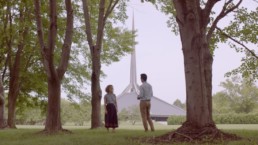‘Columbus’ Review: A Distinct, Harmonious Festival Standout
Online video essayist turned film director's debut.
Given the visual style and symmetry that is trademark to visual essay artist Kogonada, it shouldn’t be surprising that his directorial debut, which premiered in the ‘Next’ category at Sundance, plays with equal devotion to the pure harmony of images.
Set in Columbus, Indiana, which turns out to be one of the architectural capitals of the United States, we follow two protagonists who form a sort of intellectual romance as a way to get through their own difficult family times. Jin (John Cho) who is only in town because his father is in a coma, meets Casey (Haley Lu Richardson), a young local who didn’t go to college to help take care of her mother. As two intelligent and thoughtful people both in a challenging limbo period in their lives, despite their age difference, the journey of the film becomes watching them bond and help one another overcome adversity with plenty of conversations and visual symbolism about the meaning of architecture sprinkled along the way.
The cliche ‘location as a character’ is one of my least favorite sayings because it gets overused so much that it means little anymore when used in press and marketing. In most cases, this is a way of saying that a movie has some nice skyline establishing shots sprinkled between scenes. However, when a location truly becomes an integral part of the film, the results become some of my favorite. This is a film fully entangled in its home city. The architectural harmony of Columbus ties into the way the film is photographed: every image is carefully constructed, replacing realism with order and composition in a way that perfectly encapsulates each scenario. This is a bold move for a low-budget film: usually, these films are focused on creating raw authenticity in their images.
“Columbus” aims for a visual poetry that’s unlike anything we’ve seen, but again matches its story to perfection.
“Columbus” aims for a visual poetry that’s unlike anything we’ve seen, but again matches its story to perfection. The protagonists spend much of the film exploring the city, as a tool to express their emotions, which buildings resonate with them and why. Jin disdains architecture because it reminds him of his father, whereas Casey cherishes it because it provides her a way out of her fragile relationship with her mother. All of this symmetry and meaning is so tightly packed together, with pieces that connect so harmoniously, that the whole piece speaks as one distinct voice. Nothing is wasted here, it all ties into the picture.
Two major points of this are the performances by John Cho and Haley Lu Richardson, essential in not making this anti-realist movie completely alienate the viewers. They’re both people easy to fall for and together have some poignant interactions that speak truth to both of their situations. I found myself rooting for the more spirited romance we’re used to seeing in movies because I wanted the two together so badly, but like the rest of the film, it goes for something more poetic in the lack of sexuality. It is again more about the intellectual connection, one that is relatable for any of us who have met people (of both genders) that stimulate these feelings.
In the wake of Sundance, many great films blur together inevitably, and the challenge to find something that truly sticks becomes great. Amidst the greatness, “Columbus” and its distinctive visual style, matched with great leading actors, stands among this crowd. It’s one I’m especially proud to champion given Kogonada’s background as an online video essayist, but in its own right makes a great case for a powerful directorial debut.
H. Nelson Tracey
Nelson is a film director and editor from Denver based in Los Angeles. In addition to writing for Cinemacy, he has worked on multiple high profile documentaries and curates the YouTube channel "Hint of Film." You can check out more of his work at his website, hnelsontracey.com

